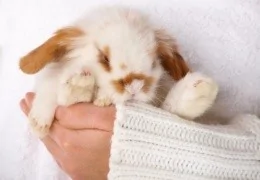Its name says it all: the Vienna blue rabbit comes from Austria. Not only is it beautiful with its shiny blue-grey...
THE TAN RABBIT
INTRODUCTION
The original coat colour of the Tan rabbit is one of its main characteristics. Its characteristic black with hints of orange attracts attention and is the key to the fact that many breeders would like a ‘piece’ of this rabbit for the creation of new breeds.
THE ORIGIN OF THE TAN RABBIT
This rabbit comes from England, where a breeder took the first step towards its birth in 1883, by crossing Dutch rabbits of unknown colour, silver-black rabbits of many shades and wild rabbits with pale coloured fur.
The rabbits bred without problem, so that every few years new offspring with new characteristics appeared. One of these was the tan markings.
‘Tan’ is the name given to the colour of the hull, which is the bark of the tree used for tanning. It corresponds to a golden brown or light reddish-brown colour. In English, this bark is known as tanbark and that is how the animal got its name.
Going back to the offspring born with the tan colour, the breeders selected the specimens which had this most marked characteristic and continued with the crossbreeding until they arrived at the present breed.
WHAT IS THE TAN RABBIT LIKE?
WEIGHT: 3.62-4.08kg.
1. TYPE - Long, slender with well tucked up muscular flank, clearly arched back with well rounded loins and hindquarters. Long, fine head. Tight and free from heaviness. Tail straight and carried in line with the spine. Forefeet long, slender in bone and perfectly straight. Hind feet long, slender and flat (The term ‘feet’ means from the junction of the forelegs to the body and from the toes of the hind feet to the hock joint). General appearance should be graceful and in a constant state of alertness characteristic of the breed.
2. COLOUR : No colour other than black and tan. No white or other rare colour between black and tan. The colour in both black and tan should reach very close to the skin. Distribution of black (body colour) and tan (marking). Head and cheeks should be black. The same colour reaching to the tip of the nose, but with a ring of tan around each eye (eye circles). Shoulders (except immediately behind the ears), loin, back, croup, sides and top of tail, black. All should be free from coloured or white hairs interspersed in the desired colour, except the sides and the side of the rump which should be bordered with long tan hairs (lateral stippling). The nostrils, dewlap, chest, belly, flanks and under part of the tail should be a single deep golden mass, inclining to red or mahogany shade. The tan sheen should be of greater importance than the actual tint. The tan should be quite light from any mixture of soot or body colour. The nape of the neck, immediately behind the ears, should be tanned, widest near the ears and tapering to a fine point in the direction of the back, thus forming a triangle. This should be large enough to be seen even when the rabbit's head is up. From the base of the triangle near the ears the tan should run downwards and if possible, meet the tan with the chest tan, thus forming a sort of band or collar around the neck. At the root of the ears, seen from the front, two tan spots, known as ‘pea spots’ should be seen, the larger the better. Hind legs - the outside of the leg reaching from the foot to the croup black, the inside rich tan. The division between black and tan should form a continuous line up the leg, free from irregularities. The tan on the inner side should be quite free from spots, pencils, bars or black. Toes completely tanned. Forelegs - the lower front part black, as free as possible from brindle. the hinder part and toes completely tanned.
3. EARS: Approximately 13 cm (5 inches) in length, well set on and sloping backwards.
- COLOUR: Outside black and inside tan all over. If inside tan all over, even better. Ears free from white tips, white hairs or coloured or white hairs interspersed in the desired colour.
4. COAT AND CONDITION: The coat should be of good quality, short and very strong in texture. Condition firm in flesh and free from any looseness or tears.
EYES: Vigorous and bright with deep hazel iris.
NOTE - In case of equality in the standard of points, preference should be given to the longer and larger specimens.
FAULTS - White nails, deduct 10 points for each white nail.
THE HEALTH OF THE TAN RABBIT
The Tan rabbit can live up to 10 years. However, the care which it receives will have a great influence on its longevity.
In general, apart from the usual illnesses of the domestic rabbit, such as dental malformations or parasitic infestations, it is not usually prone to pathologies.
THE PERSONALITY OF THE TAN RABBIT
The Tan rabbit is known to be intelligent and playful. This breed has a very curious attitude towards everything around it. They are quite active and will require a lot of space to move around freely. Despite their energy, they are very gentle and tend to get along well with other animals and people. However, a gradual introduction with other pets is recommended.
CONCLUSION
If you are looking for a pet that is happy, sociable and requires both commitment and fun, then a Tan rabbit may be the perfect choice for you. Don't forget that like any pet, a Tan rabbit will need your attention and care, but in return it will reward you with unconditional love and companionship, making it a wonderful member of your family.
Leave a comment
Log in to post comments
















